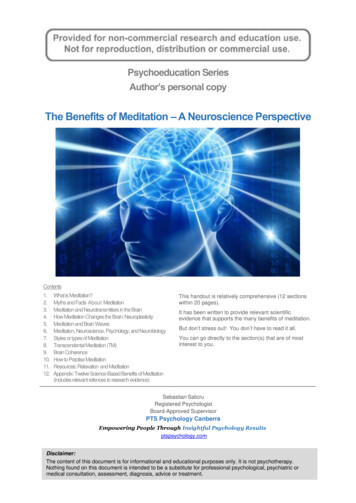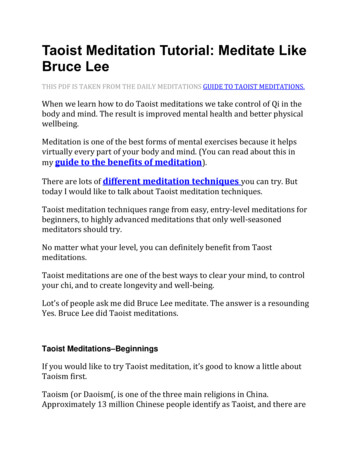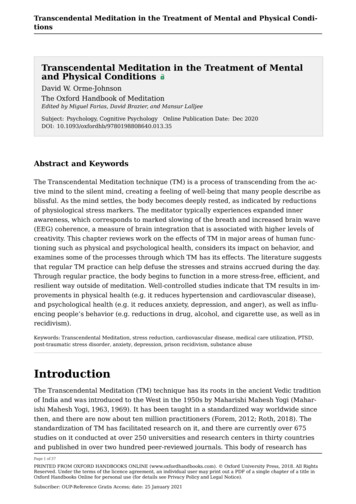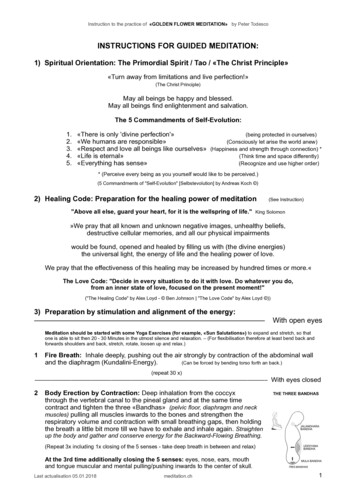
Transcription
Psychoeducation SeriesAuthor’s personal copyThe Benefits of Meditation – A Neuroscience PerspectiveContents1.2.3.4.5.6.7.8.9.10.11.12.What is Meditation?Myths and Facts About MeditationMeditation and Neurotransmitters in the BrainHow Meditation Changes the Brain: NeuroplasticityMeditation and Brain WavesMeditation, Neuroscience, Psychology, and NeurobiologyStyles or types of MeditationTranscendental Meditation (TM)Brain CoherenceHow to Practise MeditationResources: Relaxation and MeditationAppendix: Twelve Science-Based Benefits of Meditation(includes relevant refences to research evidence)This handout is relatively comprehensive (12 sectionswithin 20 pages).It has been written to provide relevant scientificevidence that supports the many benefits of meditation.But don’t stress out! You don’t have to read it all.You can go directly to the section(s) that are of mostinterest to you.Sebastian SalicruRegistered PsychologistBoard-Approved SupervisorPTS Psychology CanberraEmpowering People Through Insightful Psychology Resultsptspsychology.comDisclaimer:The content of this document is for informational and educational purposes only. It is not psychotherapy.Nothing found on this document is intended to be a substitute for professional psychological, psychiatric ormedical consultation, assessment, diagnosis, advice or treatment.
1. What is Meditation?MeditationThe word ‘meditation’ derives from Latin ‘meditari’, which means “to engage in contemplation or reflection”.Meditation can be defined as both a process and a state.Meditation is a practice where by using a technique (e.g. mindfulness, or focusing the mind on a particular object,thought or activity) you train your attention and awareness to achieve a mentally clear and emotionally calm stablestate.Meditation is the act of inward contemplation and the intermediate state between mere attention to anobject/concept and complete fusion within it.AimMeditation aims to slow down your mind by noticing what’s in your mind and sensing your body. That is, trainingyour mind to become aware of your wondering mind, automatic responses, and bodily sensations.BenefitsThe practice of meditation leads to a state of awareness, equanimity, equilibrium, balance, calmness, serenity,peacefulness, composure, poise, security, and strength.Research links meditation to significant improvements of physical, emotional and mental/psychological health,including cognitive abilities.ExperienceDuring meditation, you will experience a state of restful alertness that is extremely refreshing for the body andmind.Research on MeditationMeditation and its effect on brain activity and the central nervous system has become a major focus ofcollaborative research in neuroscience, psychology and neurobiology during the latter half of the 20th century.Summary of Science-Based Benefits of Meditation Less Stress and Anxiety. Less Depression and Improved Emotional Health. Improved Sleep (Less Insomnia). Better Memory. Longer Attention Spans. Decreased Blood Pressure. Better Pain Management. Assistance in Overcoming Addictions. Greater Self-awareness. More Kindness and Positive Emotions. In the following pages, I provide more details about these benefits along with specific references toresearch evidence.PTS Psychology Canberra2
2. Myths and Facts About MeditationMyths About MeditationFacts About Meditation1. Meditation is not for me because I can't1. Meditation is simply about noticing yourseem to quiet my mindThe idea that you have to quiet your mind tohave effective meditation practice, or thatyou’re not supposed to have any thoughts whileyou meditate, is completely false.2. It takes years of practice to benefit fromthoughts.Meditation is not about stopping your thoughts ortrying to empty our mind. Both of these approachesonly create stress and more noisy internal chatter.The nature of the mind to move from one thought toanother is in fact the very basis of meditation.2. The benefits of meditation are both immediatemeditation.You don’t need months or years to benefit fromor perfect your meditation. The very notion ofperfection is counterproductive.3. I don’t have time to meditate.and long-term.You can begin to experience benefits the first timeyou meditate and in the first few days of dailypractice.3. If you make meditation a priority, you will do it.I’m busy, busy, busy. So busy. You’ve no ideaof how shockingly busy I am!We all are busy. Meditating in the morning will focusyou and make your day go slower. You can actuallyget more things done and feel more productive aftermeditation.Because meditation sharpens your focus and lowersstress, you actually can fit more in if you take thetime to practice it.In life’s paradoxical way, if you spend time meditatingon a regular basis, you will actually have more time.You will notice that you’re able to accomplish morewhile doing less.4. Meditation is a religious practice.4. Meditation is a practice that takes you beyondMeditation and religion are two very differentconcepts. Religion is an organised system ofbeliefs, ceremonies, and rules used to worshipa god or a group of gods.Meditation is not about praying either.5. Meditation will solve of my problems.the noisy chatter of the mind into a place ofstillness and silence.While most meditation practices are rooted inBuddhism and Hinduism, the practice of meditationdoesn’t require any specific spiritual belief. You canbe an atheist, agnostic, spiritual or religious personand practice meditation without any conflict.5. The real benefits of meditation are what happensSome people expect that meditation will solveall their problems, or that they will experiencevisions, see colors, levitate, hear a choir ofangels and trumpets, or a glimpse ofenlightenment when they meditate.Yes, right!in the other hours of the day when you are goingabout your daily life.After a meditation session, you will take some of thestillness and silence of your practice with you. Thiswill allow you to be more peaceful, calm, serene,centered, creative, compassionate, tolerant, andloving to yourself and others.PTS Psychology Canberra3
3. Meditation and Neurotransmitters in the BrainWhat are Neurotransmitters?Neurotransmitters are chemical messengers in the body. Their job is to coordinate the transmission of signalsfrom one nerve cell to the next. These target cells may be in muscles, glands, or other nerves.Neurotransmitters regulate a wide variety of brain processes including: Mood and emotions (e.g. fear, pleasure, joy, anger); Memory; attention; concentration; alertness; energy; appetite; cravings; sleep; and Perception of pain.Neurotransmitters play a key role in modulating and regulating behavior and anxiety. Meditation releasesneurotransmitters that modulate anxiety.Meditation naturally boosts the following five neurotransmitters.Five Key Neurotransmitters Released by the Brain During MeditationNeurotransmitterEffects on the brain1. SerotoninSerotonin is also known by scientists as the “happy” neurotransmitter. It is key to helpingrelay signals from one part of the brain to another.Serotonin is an inhibitory neurotransmitter, and has a profound impact on our mood, appetite,blood clotting, sleep, and the body’s circadian rhythm, contributing greatly to our overall state ofwell-being.When we don’t have enough Serotonin, we feel depressed and when we have enough, wehave a sense of wellbeing. A number of studies show that meditation such as mindfulnessincreases serotonin.2. EndorphinsEndorphins are the “feel good” neurotransmitter. They inhibit pain signals and create anenergised, euphoric feeling. They are also the body’s natural pain relievers.Perhaps the most widely known, endorphins are most associated with exercise. Runner’s“high” is a common effect and similar descriptions have been given to many other activities inthe exercise category.Research also indicates that laughter releases endorphins.Meditation studies have shown increases in endorphins after meditation are at higher levels thanexercise.3. GABA(GammaAminobutyricAcid)4. DHEA5. CortisolGABA is a mood regulator, and a major inhibitor of the central nervous system. It isassociated with feelings of calm. Not having enough of this chemical can create problemsincluding anxiety, nervousness, racing thoughts, and sleeplessness. In 2010, Psychiatristsat the Boston University School of Medicine found a 27% increase in GABA levels after only 60minutes of meditation.Although DHEA is technically a hormone, it acts directly on neurotransmitter systems to regulatesynaptic transmission. When in a balanced state, the presence of DHEA facilitates what we callthe “longevity molecule”. Meditation stimulates the correct amount of DHEA which in turn puts usin a position to take advantage of the “DHEA effect”.Cortisol is a crossover between a hormone and a neurotransmitter. It is considered to be relatedto stress and whether it is acting as a hormone or a neurotransmitter. If you have too much,you will experience high levels of stress. Meditation helps to reduces cortisol levels.PTS Psychology Canberra4
4. How Meditation Changes the Brain: NeuroplasticityNeuroscience research has proven that meditation can make real, lasting changes in your brain in key regions forattention, cognition, memory, fear and learning.Seven Ways Meditation Can Make Real Changes in Your BrainBrain RegionType of Change in the BrainMeditation Can Thicken Your Prefrontal CortexOur prefrontal cortex (PFC) is our attentional control centre. It helps us plan and organise. Itis the part of the brain that most separates us from other animals. As you age, your prefrontalcortex becomes thinner. Meditation, however, can maintain the thickness of yourprefrontal cortex through aging. According to a study by Dr. Sarah Lazar, at Harvard, longterm meditators in the 40s and 50s had the prefrontal cortex thickness of 20-30-year olds.Reference: Lazara, et al. (2005). Meditation experience is associated with increased cortical thickness.Neuroreport, 16(17), 1893-1897. 02/Mediation Can Increase the Density of Your Grey MatterGrey (or gray) matter is a major component of the central nervous system. It is the mass ofour cells and dendrites that make up most of our brain and fine interconnections. Einstein, forexample, is said to have had more grey matter than the average person. Dr Lazardemonstrated that just an 8-week course in meditation increased grey matter density.Reference: Hölzel, B. K., Carmody, J., Vangel, M., Congleton, C., Yerramsetti, S. M., Gard, T., & Lazar,S. W. (2010). Mindfulness practice leads to increases in regional brain gray matter density. PsychiatryResearch, 191(1), 36-43. 65/Meditation Can Increase the Density of Your HippocampusOur hippocampus is the area of our brain responsible for many types of memory. Meditators– some with only weeks of meditation – had more grey matter volume in their hippocampalareas compared to non-meditators. More grey matter means more connections whichcan mean greater learning and memory abilities.Reference: Luders, E., Kurth, F., Toga, A. W., Narr, K. L., & Gaser, C. (2013). Meditation effects withinthe hippocampal complex revealed by voxel-based morphometry and cytoarchitectonic probabilisticmapping. Frontiers in Psychology, 4, 398. https://doi.org/10.3389/fpsyg.2013.00398Meditation Can Decrease the Activity of the Amygdala – your ‘Fight or Flight’ responseMost parts of our brain thicken and increase their connectivity with meditation. Youramygdala, which is responsible for your ‘fight or flight ‘response, shrinks. Therefore, itcan fire less often as you increase your meditation practice, and with long termmeditators it can even decreases its size. This explains why meditators can be cool instressful situations.Reference: Hölzel, B. K., Carmody, J., Evans, K. C., Hoge, E. A., Dusek, J. A., Morgan, L., Pitman, R.K., Lazar, S. W. (2009). Stress reduction correlates with structural changes in the amygdala. SocialCognitive and Affective Neuroscience, 5(1), 11-7. https://doi.org/10.1093/scan/nsp034Meditation Can Quiet Your Default Mode Network (DMN)Another region that decreases its activity is your default mode network (DMN). Default modenetwork is the network that links your ‘Prefrontal Cortex’ and your ‘Posterior CingulateCortex’. It’s responsible for that endless chatter that goes on in your brain when youare at rest. According to a Harvard study, 46.9% of our thoughts are about the past or thefuture, as opposed to the present moment. According to that study, this makes us unhappy.Meditation down-regulates the activity of the DNM, quieting the chatter and giving us themental space for insight and to focus on what we want.Reference to Harvard Study: Killingsworth, M. A., & Gilbert, D. T. (2010). A wandering mind is anunhappy mind. Science, 330(6006), .php?action getRecordDetail&idt 23452164References to DFM: Garrison, K. A., Zeffiro, T. A., Scheinost, D., Constable, R. T., & Brewer, J. A.(2015). Meditation leads to reduced default mode network activity beyond an active task. Cognitive,Affective & Behavioral Neuroscience, 15(3), PMC4529365/PTS Psychology Canberra5
Meditation Can Increase Your Compassion and Perspective TakingIn a study of meditators engaging in a compassion-based meditation (in which participantswish for good things for others in the world), scientists saw actual changes in the brain inareas related to compassion. For example, they saw an increase in activity in the temporoparietal junction, the area of the brain involved in compassion, empathy and perspectivetaking.Reference: Lutz, A., Brefczynski-Lewis, J., Johnstone, T., & Davidson, R. J. (2008). Regulation of theneural circuitry of emotion by compassion meditation: effects of meditative expertise. PloS one, 2267490/Meditation Has Been Shown to Reduce Overall Brain AgingAccording to the work of Dr. Eileen Luders at UCLA who undertook an extensive studylooking at MRI of meditators and non-mediators, the brain of a long-term meditator at 50years old looked on average 7.5 years younger, compared to non-meditators. This is acrossa number of different regions. And even better, the definition of a long-term meditator wassomeone who had practised an average of only 5 years.Reference: Luders E., Kurth F., Mayer E.A., Toga A.W., Narr K.L., Gaser C. (2012). The unique brainanatomy of meditation practitioners: Alterations in cortical gyrification. Frontiers Human Neuroscience29(6), 34. n and NeuroplasticityNeuroplasticity, also known as ‘brain plasticity’,refers to changes in neural pathways andsynapses which are due to changes in behavior,environment and neural processes.Neuroplasticity has replaced the formerlyheld view that the brain is a physiologicallystatic organ, and explores how – and in whichways – the brain changes throughout life.Neuroplasticity occurs on a variety of levels, ranging fromcellular changes due to learning, to large-scale changes involvedin cortical remapping in response to injury. The role ofneuroplasticity is widely recognised in healthy development,learning, memory, and recovery from brain damage.When it comes to your brain, you actually can teach an old dog new tricks. Once thought to be hard-wired afterearly childhood, the brain actually has a remarkable ability to change and heal itself. Known as neuroplasticity,this remodelling due to our environment, behavior, and feelings happens throughout our whole lives.PTS Psychology Canberra6
How Meditation Shapes Your Brain – For the better!In summary, meditation can make real significant positive changes in your brain.Meditation profoundly impacts the functions of the brain in addition to exhibiting other biological effects.Meditation is a source of positive affect (expression of cheerfulness, enthusiasm, energy, and joy).Meditation can be extremely beneficial (life-changing) for you, but only if you actually sit down and do it!PTS Psychology Canberra7
5. Meditation and Brain WavesWhat are brain wavesAt the root of all our thoughts, emotions and behaviours is the communication between neurons within our brains.Brainwaves are produced by synchronised electrical pulses from masses of neurons communicating with eachother.Brain waves are measured by frequency, which is cycles per second or hertz (Hz), and they range from very slowto very fast. Humans display five different types of electrical patterns or ‘brain waves’ across the cortex thatcorrespond to different brain activities.Brain waves can be observed with an EEG (or electroencephalograph) – an instrument that allows researchers tonote brain wave patterns. Each brain wave has a purpose and helps serve us in optimal mental functioning.Meditation enables you to move from higher frequency brain waves to lower frequency, which activates differentcentres in the brain. Slower wavelengths (more time between thoughts) enable greater opportunity to skilfullychoose which thoughts you invest in and what actions you take. When slower brainwaves are dominant, we canfeel tired, slow, sluggish, or dreamy. The higher frequencies are dominant when we feel wired or hyper-alert.Five Types of Brain Waves or States:1. Gamma State (between 40–100Hz). This is the state of hyperactivity and active learning. Gammastate is the most opportune time to retain information. This is why educators often have audiencesjumping up and down or dancing around – to increase the likelihood of permanent assimilation ofinformation. Over stimulated, however, can lead to anxiety.2. Beta State (between 12–40Hz). This is where we function for most of the day. Beta State is associatedwith the alert mind state of the prefrontal cortex. This is a state of the ‘working’ or ‘thinking mind’(analytical, planning, assessing, and categorising).3. Alpha State (between 8–12Hz). This is when brain waves start to slow down out of thinking mind. Wefeel more relaxed, calm, peaceful and grounded. We often find ourselves in an Alpha State after ayoga class, a walk in the woods, a pleasurable sexual experience, or during any activity that helpsrelax the body and mind. We are lucid, reflective, alert, and with mind/body integration. Thehemispheres of the brain are more balanced (neural integration).4. Theta State (between 4–8Hz). When you are extremely relaxed, your brain produces theta waves.Then you are able to begin meditation. At this the point, where the verbal/thinking mind transitions tothe meditative/visual mind. We begin to move from the planning mind to a deeper state ofawareness, with stronger intuition, more capacity for wholeness and complicated problemsolving. The Theta state is associated with visualisation.5. Delta State (between 0–3Hz). These are the slowest recorded brain waves in human. They are foundmost often in infants as well as young children. Tibetan monks who have been meditating for decadescan reach this in an alert, wakened phase, but most people reach this final state during deep,dreamless sleep.PTS Psychology Canberra8
6. Meditation, Neuroscience, Psychology, and NeurobiologyMeditation and its effect on brain activity and the central nervous system became a focus of collaborative researchin neuroscience, psychology and neurobiology during the latter half of the 20th century.Research on meditation reveals that its effects on the brain can be divided into two main categories:1.State changes and trait changes, respectively alterations in brain activities during the act of meditating; and2.Changes that are the outcome of long-term practice.Matthieu Ricard, a French Buddhist monk who used to be a biochemist, says meditation fundamentally rewires thebrain towards joy. Research suggests he’s right. Brain scans and EEGs reveal that Buddhist monk M. Ricard has largest capacity for happiness ever recorded.Meditation “completely changes your brain and therefore changes what you are”, says M. Ricard.He says you can do this by learning how to let your thoughts drift.M. Ricard may seem like an unusual person to hold the title – but is the world’s happiest man, according toresearchers.The 66-year-old turned his back on Parisian intellectual life 40 years ago and moved to India to study Buddhism.He is now a close confidante of the Dalai Lama and respected western scholar. He believes meditation can alterthe brain and improve people’s happiness in the same way that lifting weights puts on muscle.Listen to this story on this BBC World Service podcast released on 18 February 2020 – Available for over a year.How meditation changes your brainhttps://www.bbc.co.uk/sounds/play/w3csyx39PTS Psychology Canberra9
7. Styles of MeditationThere are three major styles or types of meditation.The first two are types of Mindfulness Meditation (MM) – a form of attentional controltraining by which individuals develop the ability to direct and maintain attention towardsthe present moment. MM can not only reduce mind-wandering during practise, but it canalso influence mental performance after practise, and improve well-being in everydaylife. Hence, it has developed as a clinical intervention.1. Focused Attention – or Concentrative – Meditation (FAM) focuses on clearingyour mind of thought by concentrating attention on a single object, thought, sound orvisualisation. It emphasises ridding your mind of attention and distraction. Thismeditation entails paying attention to the breath, bodily sensations, an idea or feeling,or a mantra (image or calming sound). Zazen and Vipassana meditations areexample of this style of meditation.2. Open Monitoring Meditation (OMM) entails disengaging emotionally by justobserving, being present, and mindful. That is, broadening awareness of all aspectsof your environment, train of thought, and sense of self. It may include becomingaware of thoughts, feelings or impulses that you might normally try to suppress.3. Automatic Self-Transcending (AST) involves neither concentration nor training themind. Includes a technique designed to transcend their own activity. This contrastswith focused attention, which keeps attention focused on an object; and openmonitoring, which keeps attention involved in the monitoring process. Automaticself-transcending allows the active thinking mind to experience quieter and quieterlevels of thought, and then transcend thought and experience the self – our ownunbounded nature. This is Transcendental Meditation (TM). Mindfulness Meditation (MM) consists of focused attention meditation (FAM) and openmonitoring meditation (OMM). They both reduce activation of the default mode network(DMN) and mind-wandering. Both FAM and OMM aim to keep your attention away fromdistractors, such as particular bodily sensations, feelings, and thoughts, which evokemind-wandering. Compared with FAM, it is more difficult to disengage attention fromthese distractors during OMM because meditators do not have a target object.Fujino, M., Ueda, Y., Mizuhara, H., Saiki, J., & Nomura, M. (2018). Open monitoring meditation reduces the involvement ofbrain regions related to memory function. Scientific Reports, 8(1), 1-10. PTS Psychology Canberra10
8. Transcendental Meditation (TM)Meta-analyses (statistical analysis of multiple research studies) have found that TM is more effectivethan other meditation or relaxation techniques in producing a range of results, such as: Reducing AnxietyEppley, K. R., Abrams, A. I., & Shear, J. (1989). Differential effects of relaxation techniques on trait anxiety: A meta‐analysis.Journal of Clinical Psychology, 45(6), 5:6 957::AID-JCLP2270450622 3.0.CO;2-Q Increasing Self-actualisationAlexander, C. N., Rainforth, M. V., & Gelderloos, P. (1991). Transcendental meditation, self-actualization, and psychologicalhealth: A conceptual overview and statistical meta-analysis. Journal of Social Behavior and Personality, 6(5), 4-001 Decreasing Blood PressureRainforth, M. V., Schneider, R. H., Nidich, S. I., Gaylord-King, C., Salerno, J. W., & Anderson, J. W. (2007). Stress reductionprograms in patients with elevated blood pressure: A systematic review and meta-analysis. Current Hypertension Reports,9(6), 520-528. https://europepmc.org/article/PMC/2268875 Reducing AddictionAlexander, C. N., Robinson, P., & Rainforth, M. (1994). Treating and preventing alcohol, nicotine, and drug abuse throughTranscendental Meditation: A review and statistical meta-analysis. Alcoholism Treatment Quarterly, 11(1-2), 13-87.https://doi.org/10.1300/J020v11n01 02Transcendental Meditation (TM) refers to a specific form of silent, mantra meditation and less commonly to theorganizations that constitute the Transcendental Meditation movement.[1][2] Maharishi Mahesh Yogi created andintroduced the TM technique and TM movement in India in the mid-1950s (Wikipedia).Transcendence is the experience of the united source of all there is. It is a non-local experience, a bit like anindividual wave melting into its source, the infinite ocean (e.g. in touch with our higher self).In modern times, the effect of this experience on our brains can be measured through a variety of brain-imagingsystems. This experience affects a much larger part of our brain, including the so-called “hidden reserves” (HumanPhysiology, 25: 171–180, 1999).PTS Psychology Canberra11
PTS Psychology Canberra12
9. Brain CoherenceBrain coherence is a measure of how effectively two sites are able to link and unlink. This connectivity describesthe networks of functional and anatomical connections across the brain. Coherence is a mathematical method thatcan be used to determine if two or more sensors, or brain regions, have similar neuronal oscillatory activity with eachother.Brain and Heart Coherence is Essential in Managing Stress, Anxiety, andSustainable Behaviour ChangeThe heart sends more information to the brain thanthe other way around.Coherence happens when the heart, mind, and emotionsare aligned and work together harmoniously.One of the most effective ways to reduce stress andanxiety is to change the rhythm of the heart, becauseit sends a different neural message to the brain.So, by shifting the rhythm of your heart, you can quicklyimprove your brain functioning, and reduce your stress andanixeity.HeartMath Institute Science – Scientific Foundation of the HeartMath Systemhttps://www.heartmath.org/science/Connecting with the Heart's Intelligence: Rollin McCratyhttps://www.youtube.com/watch?v KurPSsFNZK0During normal activities, brain coherence is quite low (between 30% and 40%). However, through transcending, themind experiences a state of unity and this has an immediate, measurable impact on the brain. The brain startsworking more as a unified whole. The video below shows this process taking place in real-time.Upgrade Your Executive Brain: EEG Nexus Demo of Transcendental Meditation Practice 2min(This short video illustrates the rapid and sustained high levels of alpha brainwaves during onset of TM practice (eegsigal and coherence of the prefrontal cortex, F3-F4).https://www.youtube.com/watch?v XNkir2vzq3oPTS Psychology Canberra13
MAHARISHI’S, T. M. SCIENTIFIC RESEARCH ON MAHARISHI’S TRANSCENDENTAL MEDITATION AND TMSIDHI PROGRAM VOLUMES 1-7.https://scholar.google.com/scholar?cluster 8525981138659689724&hl en&as sdt 0,5http://dl.globalgoodnews.com/pdf/research/doj biblio tm vols 1-7.pdf10. How to Practise MeditationWhen we meditate, we use an object to focus our attention such as our breath, an image, ora mantra, which allows our mind to relax into this silent stream of awareness.When thoughts arise, as they inevitably will, we don’t need to judge them or try to push themaway. Instead, we acknowledge them and gently return our attention to our object ofattention.In every meditation, there are moments – even if only microseconds, when the mind is ableto experience the refreshment of pure awareness.As you meditate on a regular basis, you will spend more and more time in this state ofstillness, silence, and expanded awareness.Readings on How Meditation Helps with DepressionHow Meditation Helps with s Can Change Brain Patternsof ssion/PTS Psychology Canberra14
11. ResourcesThe Science of Meditation – Educational ResourcesThe Science of Meditationhttps://www.youtube.com/watch?v BI5JNDs-AzkSara Lazar - How Meditation Changes the Brainhttps://www.youtube.com/watch?v GOIwtTmpc-IHow Meditation Can Reshape Our Brains: Sara Lazar at TEDxCambridge 2011https://www.youtube.com/watch?v m8rRzTtP7Tc&t 14sThe Meditating Brain - Pt. 1 with Dr. Sara Lazarhttps://www.youtube.com/watch?v lJMBkg 8OdsDr. Sara Lazar: The Impact of Mindfulness Training on Brain Plasticity andCognitionhttps://www.youtube.com/watch?v 1vDN2UcRcqYHow Meditation Impacts the Brain and Implications for Healthhttps://www.youtube.com/watch?v PCymeuQECOsThe Scientific Power of Meditationhttps://www.youtube.com/watch?v Aw71zanwMnYHow Does Meditation Change the Brain? – Instant Egghead #54https://www.youtube.com/watch?v q0DMYs4b2Yw10 Mind-Blowing Benefits of Meditationhttps://www.youtube.com/watch?v wXsxwIJnUJkRelaxation and Meditation ResourcesDeep Sleep Meditations (Suitable if you suffer from insomnia)Deep Sleep MeditationDeep Sleep Music – 4 Hours – Collection 3GUIDED SLEEP MEDITATION WITH DEEPAK CHOPRA – DAY 1Fall Asleep Fast Deep Sleep Meditation for Insomnia / Mindful Movement[Try Listening for 3 Minutes] FALL ASLEEP FAST DEEP SLEEP RELAXING MUSIC
How Meditation Changes the Brain: Neuroplasticity Neuroscience research has proven that meditation can make real, lasting changes in your brain in key regions for attention, cognition, memory, fear and learning. Seven Ways Meditation Can Make Real Changes in Your Brain Brain










